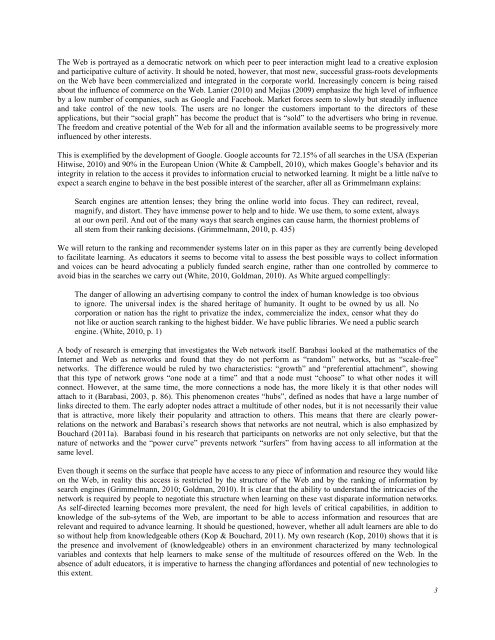April 2012 Volume 15 Number 2 - Educational Technology & Society
April 2012 Volume 15 Number 2 - Educational Technology & Society
April 2012 Volume 15 Number 2 - Educational Technology & Society
Create successful ePaper yourself
Turn your PDF publications into a flip-book with our unique Google optimized e-Paper software.
The Web is portrayed as a democratic network on which peer to peer interaction might lead to a creative explosion<br />
and participative culture of activity. It should be noted, however, that most new, successful grass-roots developments<br />
on the Web have been commercialized and integrated in the corporate world. Increasingly concern is being raised<br />
about the influence of commerce on the Web. Lanier (2010) and Mejias (2009) emphasize the high level of influence<br />
by a low number of companies, such as Google and Facebook. Market forces seem to slowly but steadily influence<br />
and take control of the new tools. The users are no longer the customers important to the directors of these<br />
applications, but their “social graph” has become the product that is “sold” to the advertisers who bring in revenue.<br />
The freedom and creative potential of the Web for all and the information available seems to be progressively more<br />
influenced by other interests.<br />
This is exemplified by the development of Google. Google accounts for 72.<strong>15</strong>% of all searches in the USA (Experian<br />
Hitwise, 2010) and 90% in the European Union (White & Campbell, 2010), which makes Google’s behavior and its<br />
integrity in relation to the access it provides to information crucial to networked learning. It might be a little naïve to<br />
expect a search engine to behave in the best possible interest of the searcher, after all as Grimmelmann explains:<br />
Search engines are attention lenses; they bring the online world into focus. They can redirect, reveal,<br />
magnify, and distort. They have immense power to help and to hide. We use them, to some extent, always<br />
at our own peril. And out of the many ways that search engines can cause harm, the thorniest problems of<br />
all stem from their ranking decisions. (Grimmelmann, 2010, p. 435)<br />
We will return to the ranking and recommender systems later on in this paper as they are currently being developed<br />
to facilitate learning. As educators it seems to become vital to assess the best possible ways to collect information<br />
and voices can be heard advocating a publicly funded search engine, rather than one controlled by commerce to<br />
avoid bias in the searches we carry out (White, 2010, Goldman, 2010). As White argued compellingly:<br />
The danger of allowing an advertising company to control the index of human knowledge is too obvious<br />
to ignore. The universal index is the shared heritage of humanity. It ought to be owned by us all. No<br />
corporation or nation has the right to privatize the index, commercialize the index, censor what they do<br />
not like or auction search ranking to the highest bidder. We have public libraries. We need a public search<br />
engine. (White, 2010, p. 1)<br />
A body of research is emerging that investigates the Web network itself. Barabasi looked at the mathematics of the<br />
Internet and Web as networks and found that they do not perform as “random” networks, but as “scale-free”<br />
networks. The difference would be ruled by two characteristics: “growth” and “preferential attachment”, showing<br />
that this type of network grows “one node at a time” and that a node must “choose” to what other nodes it will<br />
connect. However, at the same time, the more connections a node has, the more likely it is that other nodes will<br />
attach to it (Barabasi, 2003, p. 86). This phenomenon creates “hubs”, defined as nodes that have a large number of<br />
links directed to them. The early adopter nodes attract a multitude of other nodes, but it is not necessarily their value<br />
that is attractive, more likely their popularity and attraction to others. This means that there are clearly powerrelations<br />
on the network and Barabasi’s research shows that networks are not neutral, which is also emphasized by<br />
Bouchard (2011a). Barabasi found in his research that participants on networks are not only selective, but that the<br />
nature of networks and the “power curve” prevents network “surfers” from having access to all information at the<br />
same level.<br />
Even though it seems on the surface that people have access to any piece of information and resource they would like<br />
on the Web, in reality this access is restricted by the structure of the Web and by the ranking of information by<br />
search engines (Grimmelmann, 2010; Goldman, 2010). It is clear that the ability to understand the intricacies of the<br />
network is required by people to negotiate this structure when learning on these vast disparate information networks.<br />
As self-directed learning becomes more prevalent, the need for high levels of critical capabilities, in addition to<br />
knowledge of the sub-sytems of the Web, are important to be able to access information and resources that are<br />
relevant and required to advance learning. It should be questioned, however, whether all adult learners are able to do<br />
so without help from knowledgeable others (Kop & Bouchard, 2011). My own research (Kop, 2010) shows that it is<br />
the presence and involvement of (knowledgeable) others in an environment characterized by many technological<br />
variables and contexts that help learners to make sense of the multitude of resources offered on the Web. In the<br />
absence of adult educators, it is imperative to harness the changing affordances and potential of new technologies to<br />
this extent.<br />
3

















